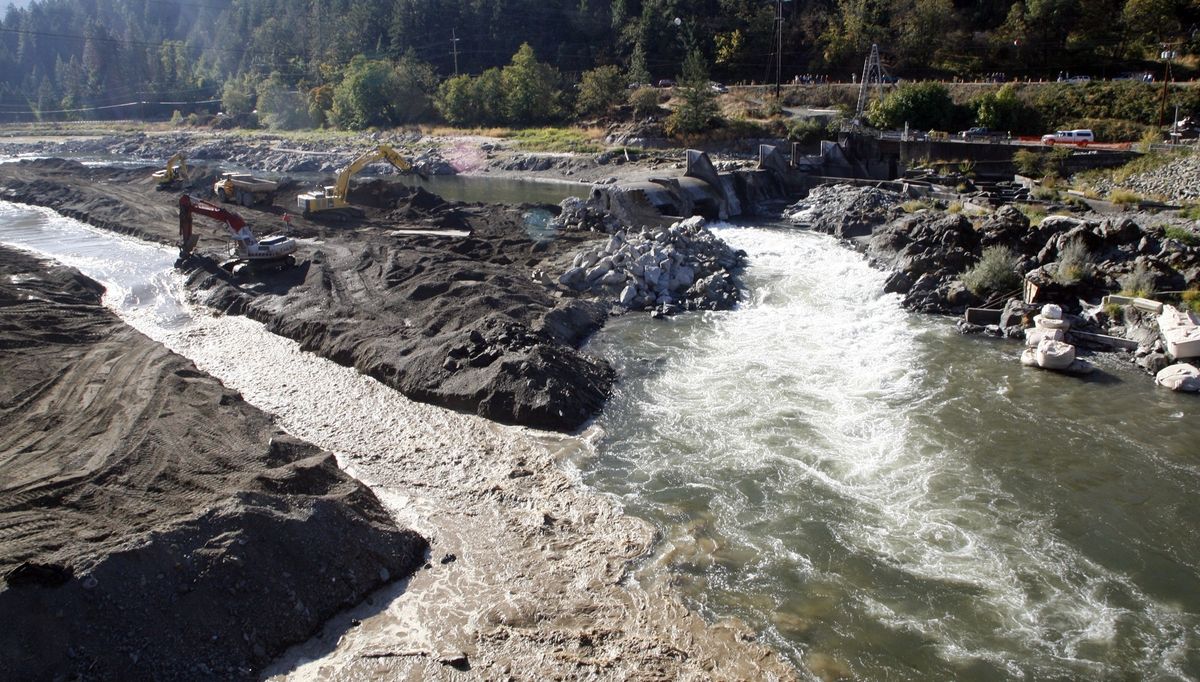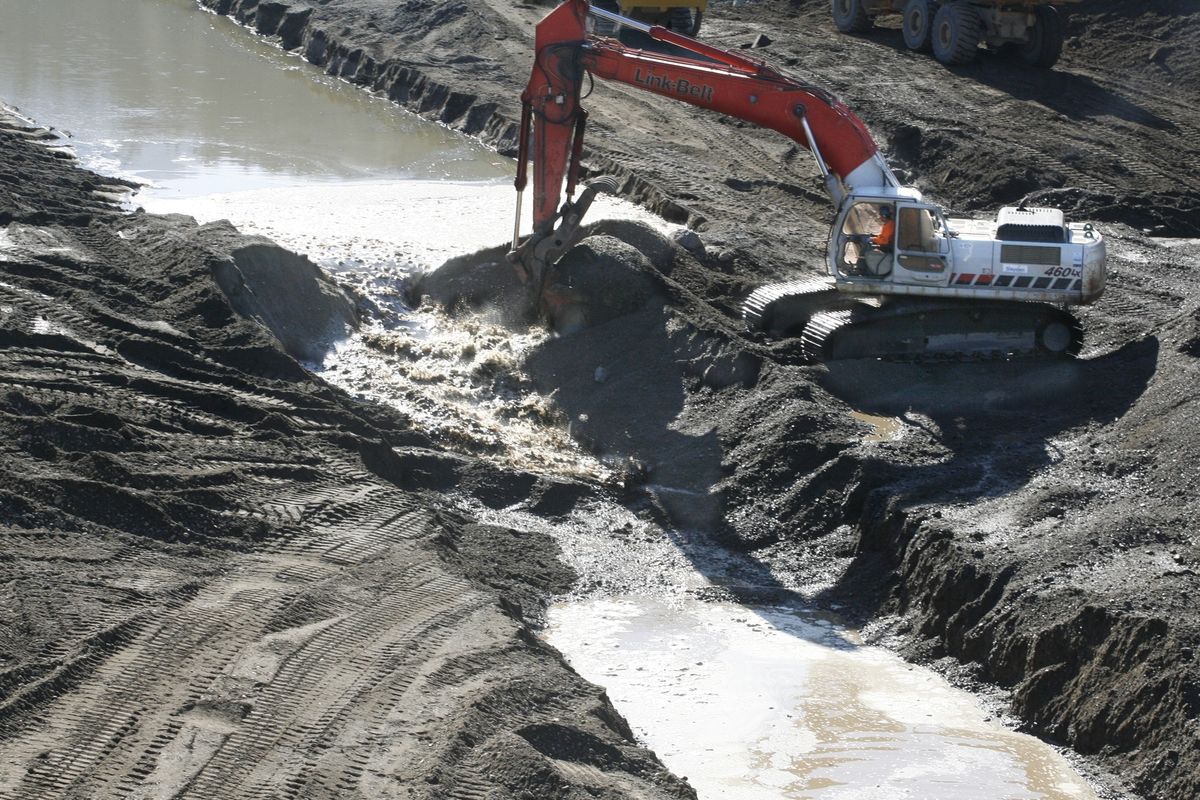Rogue move frees river after 88 years
Series of dams slated for removal in region
Associated Press Two channels of the Rogue River meet Friday after two berms were removed, allowing free flow for the first time in 88 years. (Associated Press / The Spokesman-Review)
GRANTS PASS, Ore. – For years, the water stored by the Savage Rapids Dam has nurtured the green bean fields and grazing pastures of southern Oregon, turning them into a lush region of bounty.
But there has been a price – the death of thousands of fish, which slammed themselves into the concrete wall of the dam in a futile effort to head upstream.
That picture now resembles a faded sepia-tone photograph. Many of the big farms have turned into 10-acre hobby ranches. The salmon are in danger of disappearing. And even the federal Bureau of Reclamation, the agency that harnessed rivers and irrigated the West, began saying a few years ago it would be better to just tear down the aging dam once and for all.
So they did.
On Friday, a platoon of bulldozers and earthmovers tore away at the last of the temporary earthen berms holding water behind the dam. The Rogue River rushed free, flowing through its historic channel for the first time since 1921.
“Startin’ through,” muttered Robert Hamilton, project manager for the Bureau of Reclamation, who worked on fixing, and finally dismantling, the dam for more than 20 years. “Don’t see something like this every day.”
Across the U.S., the era of dam-building that characterized the early 20th century has given way to a new era of dam breaching.
In the Pacific Northwest, where some of the biggest battles over fish and concrete have raged, the Marmot Dam on the Sandy River near Portland was demolished in 2007.
In September, an agreement was reached to remove four dams on the Klamath River in California and Oregon in what is described as the world’s biggest river restoration project.
Two dams on Washington’s Elwha River are slated for removal in 2012.
In southern Oregon, Savage Rapids is one of four dams being dismantled on the Rogue River. With Friday’s breaching, three projects are complete, and the fourth, Gold Ray Dam, 18 miles upstream from Savage Rapids, could be brought down by 2010, returning a 157-mile stretch of the river to its natural state.
Savage Rapids “has been known as the No. 1 fish killer on the Rogue River,” said Bob Hunter, who spent 20 years as a staff attorney with the environmental group WaterWatch, working to bring the dam down.
“It’s the first dam migrating salmon and steelhead meet on their way upstream, and pretty much everyone in the fishing community knew this dam was causing a great deal of harm.”
‘Our Statue of Liberty’
But the 30-foot-high, 500-foot-long irrigation dam was also providing cheap, needed water to farmers and homeowners in the Grants Pass Irrigation District, which had held a legal right since 1918 to a share of the Rogue’s waters.
Over the past two decades, rural southern Oregon had been plagued by lumber mill closures resulting from cutbacks in logging to protect the endangered spotted owl. Few were initially enthusiastic about losing their water to the threatened coho salmon, one of several species of salmon and steelhead trout that migrate up the Rogue River.
Many families enjoyed boating and water skiing on the picturesque, 3.5-mile reservoir behind the dam.
“It became, I guess, our Statue of Liberty,” said Dan Shepherd, director of the Grants Pass Irrigation District, which spent years fighting to preserve the dam.
But the combined power of the environmental movement, the federal government, the simple economics of water and concrete, and a new population that wants its rivers wild, not tamed, became too massive to fight, he said. “It was either you go out of business, or you reinvent yourself and go forward.”
The fights seemed endless. Two fishing organizations filed a challenge to the district’s application several years ago to expand its water rights. The National Marine Fisheries Service filed suit against the irrigation district, accusing it of illegally killing salmon protected by the Endangered Species Act. The irrigation district filed suits of its own to keep the dam.
Michael Lambert, a fish passage engineer for the Oregon Department of Fish and Wildlife, went to the dam to look for himself and came to the same conclusion the Bureau of Reclamation did: It was cheaper – and better – to simply tear it down and build electrically powered pumps in the river to get the Grants Pass district the water it needed.
Residents voted
In 2001, a consent decree was signed ending all the legal fights. In it, everybody got a piece of what they wanted. The dam would go, but WaterWatch and others would help the district get federal money to do the work and build a new pumping plant. The federal authorization came in 2003, and it was followed by $36 million in federal and $3 million in state appropriations.
The first preparation work began in 2006, leading up to the moments Friday when water began rushing past the old dam and cutting a course through the river’s old streambed nearby.
“You name it, we were sued by everybody,” said Shepherd, of the irrigation district. “And then they basically said that if you guys want to switch over to pumps and go with dam removal, we’ll do everything in our power to get you the money and make it happen. If you guys decide to go the other way, which was still our option, we will do everything in our power to stop you.”
The district took a vote of its own residents, and the majority favored dam removal. The electricity bill to run the new pumps is $40,000 to $50,000 a month, but spending the $14 million to $20 million needed to fix the dam would have cost $1 million a year in interest alone, he said.
“They were basically saying, ‘Quit spending the money. Get on with life,’ ” Shepherd said.

